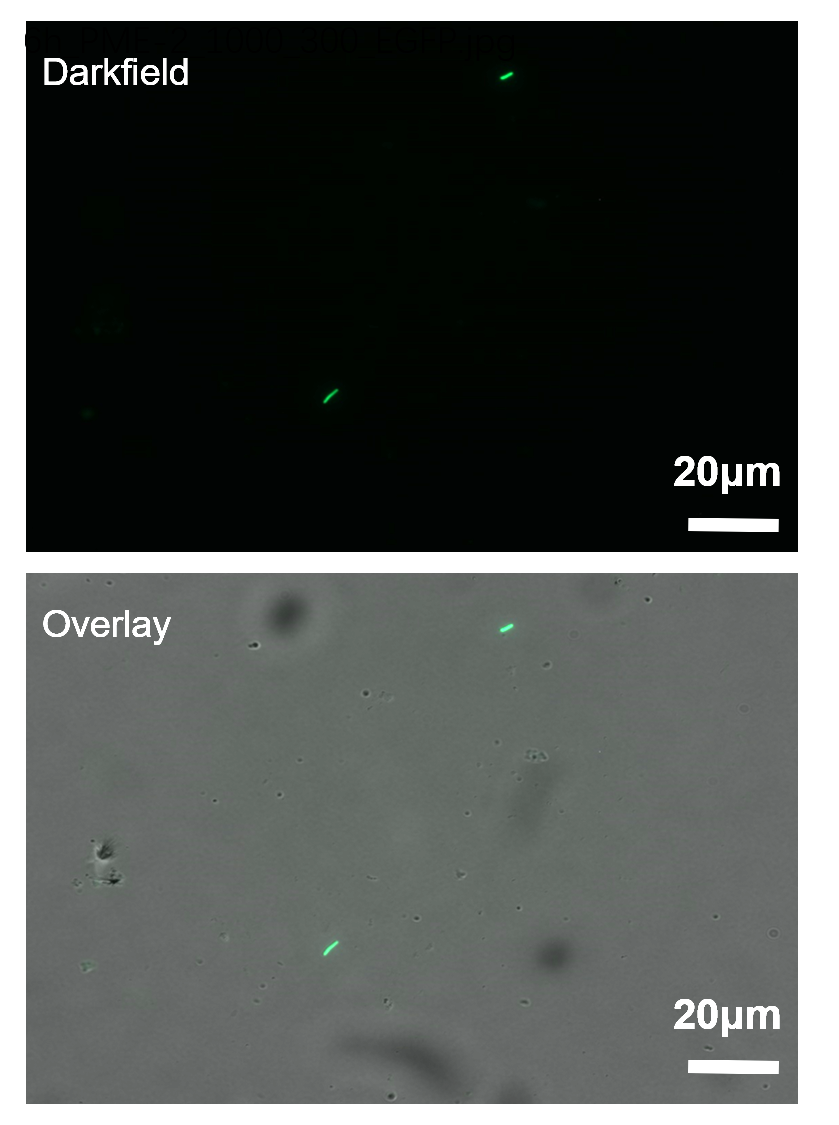Part:BBa_K1075044
Promoter(const.)-RBS34-YF1-FixJ-FixK-LambdaC-pC (pDawn)
pDawn can be used to induce transcription of a downstream gene with blue light.
The plasmid pDawn was designed by Ohlendorf et al. in 2012 together with its counter plasmid pDusk. Both plasmids are single plasmid systems, which allow the activation (pDawn) or repression (pDusk) of gene expression by blue light. They are easy to implement in the laboratory and lead to up to 460-fold activity change upon ilumination.
Usage and Biology
Ohlendorf et al. (2012) had previously designed the histidine kinase YF1, which phosphorylates FixJ in the absence of blue light. The phosphorylated FixJ drives robust gene expression from the FixK2 promotor as shown in figure 1 for both pDawn and the pDusk. Upon light absorption, net kinase activity of YF1 and consequently gene expression under control of the FixK2 promotor is greatly reduced. pDusk an pDawn enable light-repressed or light-induced gene expression in Escherichia coli and are easy to implement in the laboratory. Therefore, all components of the YF1/FixJ TCS were assembled on only one medium-copy plasmid in which YF1 and FixJ are constitutively expressed by the Lacq promotor. Target genes can be introduced via the multiple-cloning site (MCS) under the control of the pFixK2 promotor, allowing light-repressed gene expression. To obtain pDawn the light effect is inverted by the introduction of a gene-inversion cassette into pDusk. This gene-inversion cassette is based on the λ phage repressor cI and the λ phage promotor pR.
Ohlendorf et al. (2012) analyzed the system by the insertion of the red-fluorescent reporter protein DsRed Express2. That way they were able to measure up to 460-fold induction upon ilumination. However, they also found that their plasmid, which acts on gene expression level, only allows light-induced perturbations on the timescale of hours.
Further Characterization I
In addition to the literature data, further testing was conducted in 2017 by Cornell iGEM. By growing E. coli under different intensities of visible light, we can compare the relative expression levels of a FLAG-tagged control protein, superoxide dismutase, under optogenetic control.
We first inserted superoxide dismutase into the pDusk circuit. We then proceeded to incorporate a cI repressor (BBa_K2296045) and a pR promoter into the pDusk system followed by insertion of superoxide dismutase to create a light-inducible pDawn circuit.
We assessed the transcriptional activity of pDawn and pDusk in response to three different levels of light intensity from a standard laboratory fluorescent light:

Our initial characterization revealed a dose-dependence of pDusk. However, pDawn did not display a dose-dependent response in response to stimulation from fluorescent light. We suspect this to be the result of low light intensity.
Our subsequent characterization uses a significantly greater intensity of LED light:

Our results suggest a light-intensity dependence of pDusk and pDawn. Our results also show that our cI repressor biobrick successfully converted the light-repressible pDusk into a light-inducible pDawn.
In addition to dose-dependent characterization, we also conducted time-dependence characterization of pDawn following stimulation by 470 nm LED light (LTL3H3TBPADS1) with the following emission spectrum [2]:

Our initial characterization was conducted with 1 second pulses and revealed a significant lag between initial exposure and translational response:

For our subsequent characterization, we increased the intensity and pulse duration of the LED to parse out more subtle effects at earlier time points:

Our results suggest a light intensity and time-dependence of the pDawn and pDusk optogenetic circuit.
Further Characterization II
ShanghaiTech iGEM characterized the efficiency of pDawn system with mEGFP and improved it.
Results were analyzed in both visualized micrographs and normalized line graphs, which showed the qualitative and quantitative mEGFP expression level respectively.
Micrographs are listed as follows:
pDawn with T7 promoter is abbreviated as T7c below. pDawn with tac promoter is abbreviated as tac below. pDawn with modified tac promoter is abbreviated as mtac below. pDawn with YF2 is abbreviated as YF2 below.
[Go for the protocol of characterization:https://2019.igem.org/Team:ShanghaiTech_China/LightControl]
Figure 1: Representative images of pDawn-mEGFP expression under different light illumination-durations. The groups labeled ‘light-on’ were under light induction, while controls labeled ‘light-off’ were kept in the dark wrapped with aluminum foil. pictures were taken with the same parameters as the Alexa Fluor 488 dye, with the same 1000-ms exposure time for all images. The Brightfield images were captured with 300-ms exposure time.
To see more changes on pDawn, go to the websites below.
pDawn-mEGFP: https://parts.igem.org/Part:BBa_K3278000
pDawn with T7 promoter: https://parts.igem.org/Part:BBa_K3278001
pDawn with mtac promoter: https://parts.igem.org/Part:BBa_K3278002
pdawn with tac promoter: https://parts.igem.org/Part:BBa_K3278005
pDawn with YF2: https://parts.igem.org/Part:BBa_K3278006
References
1 [http://www.sciencedirect.com/science/article/pii/S0022283612000113] Ohlendorf et al. (2009) From Dusk till Dawn One-Plasmid Systems for Light-Regulated Gene Expression.
2 Lite-On Technology Corporation. Information Data Sheet for LED Lamp LTL3H3TBPADS1-132A. Retrieved from http://www.mouser.com/ds/2/239/Lite-On_LTL3H3TBPADS1-132A-Ver.A-341105.pdf
Sequence and Features
- 10COMPATIBLE WITH RFC[10]
- 12COMPATIBLE WITH RFC[12]
- 21INCOMPATIBLE WITH RFC[21]Illegal BglII site found at 2171
- 23COMPATIBLE WITH RFC[23]
- 25INCOMPATIBLE WITH RFC[25]Illegal NgoMIV site found at 63
Illegal NgoMIV site found at 195
Illegal NgoMIV site found at 289
Illegal NgoMIV site found at 582
Illegal NgoMIV site found at 1076
Illegal NgoMIV site found at 1094
Illegal NgoMIV site found at 1184
Illegal AgeI site found at 414
Illegal AgeI site found at 1542 - 1000INCOMPATIBLE WITH RFC[1000]Illegal BsaI site found at 1643
Illegal BsaI.rc site found at 525
| None |






